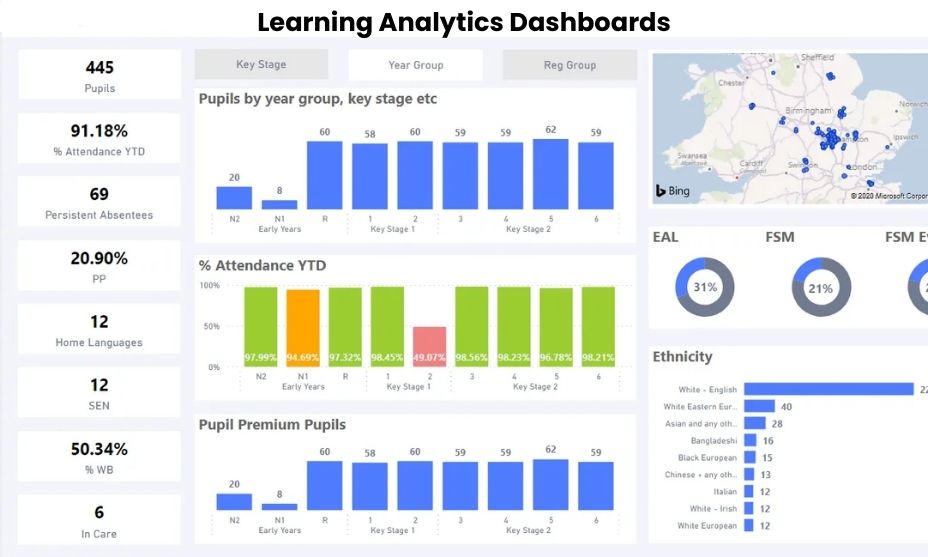What Is Learning Analytics? Top Trends 2024

Data-driven decision-making has emerged as a game-changer in the changing educational landscape. Learning analytics is a field at the crossroads of education and data science which has gained substantial prominence. It involves collecting, analyzing, and interpreting data from various learning environments to gain insights into student behavior, engagement, and performance. As the educational paradigm continues to shift, the year 2024 will witness several compelling trends in learning analytics that are reshaping the way we understand and enhance the learning experience.
What is Learning Analytics?
Learning Analytics encompasses measuring, scrutinizing, compiling, and presenting data regarding learners and their circumstances. The aim is to enhance and comprehend the associated settings or the learning process. This definition, originating from the inaugural LAK in 2011, remains valid despite the field’s expansion. Over the past decade, Learning Analytics has swiftly emerged as both an academic discipline and a thriving commercial domain. As a teaching and research field, Learning Analytics sits at the convergence of Learning (assessment and learning sciences, educational technology, and educational research), Analytics (visualization, statistics, artificial intelligence, computer or data sciences), and Human-Centered Design (sociotechnical systems thinking, usability and participatory design).
Top Learning Analytics Trends:
Companies that neglect to establish enduring and expandable data analytics structures are poised to encounter performance obstacles spanning at least two years. Within Learning and Development (L&D), data analytics has assumed paramount importance and is poised to maintain its dominance throughout 2024. The accumulation of data about learner inclinations at the individual, group, and institutional echelons holds the potential not only for enlightening insights but also for exerting a determining influence on expansion and organizational performance achievements. Below, we explain the top trends of learning analytics:
Predictive Analytics for Early Intervention
One of the foremost trends in learning analytics is using predictive models to identify students at risk of academic struggles early on. Educators and institutions can pinpoint patterns that indicate potential learning challenges by analyzing historical data. These patterns encompass factors like attendance, submission history, quiz scores, and social interactions within the digital learning environment. The power of predictive analytics lies in its ability to notify instructors and advisors about struggling students, enabling timely interventions that can prevent further setbacks and foster a supportive learning environment.
Personalization through Adaptive Learning
In the era of information overload, personalized learning experiences are gaining traction. Adaptive learning, a subset of learning analytics, tailors educational content and activities to each student’s unique learning pace, style, and preferences. Machine learning algorithms analyze a student’s performance and behavior to adjust the difficulty and format of learning materials dynamically. This approach enhances engagement and ensures that students grasp concepts thoroughly before progressing, ultimately leading to a more effective learning journey.
Ethical Considerations and Data Privacy
As the collection of learner data becomes more prevalent, concerns about data privacy and ethics have reached the forefront. Learning analytics necessitates the responsible and transparent handling of sensitive student data. Institutions and edtech companies must prioritize robust security measures and comply with relevant data protection regulations. Striking a balance between deriving insights from data and respecting students’ privacy rights is a challenge that continues to shape the direction of learning analytics in 2023 and beyond.
Integration of Multimodal Data
Learning constitutes a complex process, and there has been a recent upsurge in gathering multimodal data from diverse origins, like online discussions, video lectures, assessments, and beyond. Integrating these diverse data types provides a comprehensive view of student learning behaviors and preferences. By analyzing these data streams collectively, educators can gain deeper insights into how students engage with different learning modalities, enabling them to tailor their instructional strategies accordingly.
Emphasis on Learner Engagement
Engagement is a critical factor in the learning process. Learning analytics tools now focus on tracking and enhancing learner engagement in digital environments. Educators can identify high engagement by analyzing learning activity time, course material interaction, and discussion participation trends. These insights can inform the design of more captivating and interactive courses, fostering a more conducive learning atmosphere.
Learning Analytics Dashboards

Visual representation of data plays a pivotal role in making sense of complex information. Learning analytics dashboards provide educators and administrators with a user-friendly interface to interpret data trends effectively. These dashboards consolidate data from various sources, presenting key metrics in an accessible format. In 2024, the trend is towards more customizable and interactive dashboards, enabling educators to obtain real-time insights into student progress and engagement.
Collaboration with EdTech Companies
Collaboration between educational institutions and edtech companies is on the rise. EdTech firms provide platforms and tools that generate massive amounts of data about student interactions. These companies collaborate with educational institutions to analyze this data and extract valuable insights. This partnership facilitates the development of more effective learning technologies, enhances the learning experience, and shapes the evolution of learning analytics tools.
Embracing a Growth Mindset
Learning analytics is not only about assessing past performance but also about fostering a growth mindset among students. Educators can empower students to take ownership of their learning journey by providing them with data-driven insights into their progress, strengths, and areas for improvement. Transparently sharing analytics with students can inspire them to set goals, track their development, and actively engage in learning.
Integration into Institutional Strategies
Learning analytics is moving beyond being a mere add-on and is increasingly becoming an integral part of institutional strategies. Educational institutions recognize its potential to enhance teaching quality, improve student retention rates, and inform policy decisions. In 2024, the trend is to align learning analytics initiatives with broader institutional goals, fostering a data-informed learning system.
Emphasis on Continuous Improvement
The learning analytics landscape is in a constant state of evolution. Educational institutions and stakeholders are realizing that implementing learning analytics is not a one-time endeavor but a continuous process. Regularly evaluating the efficacy of analytics initiatives, adapting to changing educational paradigms, and incorporating feedback from educators and students are trends that define the year 2024 and beyond.
Final Verdicts
Learning Analytics has emerged as a dynamic force in the education landscape, uniting data science and learning to revolutionize decision-making. The trends of 2024 underscore its pivotal role. From predictive insights aiding struggling students to personalized learning paths, ethical considerations, and multidimensional data integration, Learning Analytics enhances engagement, empowers students, and aligns institutional strategies. As the year unfolds, these trends usher in a new era of data-driven education, fostering continuous improvement and a holistic understanding of the learning journey.


